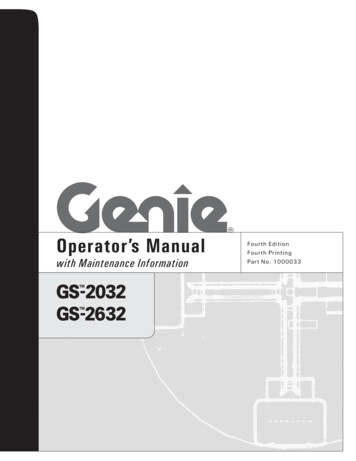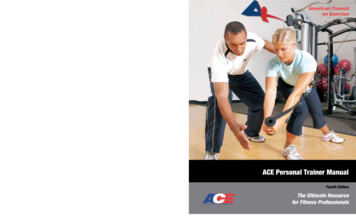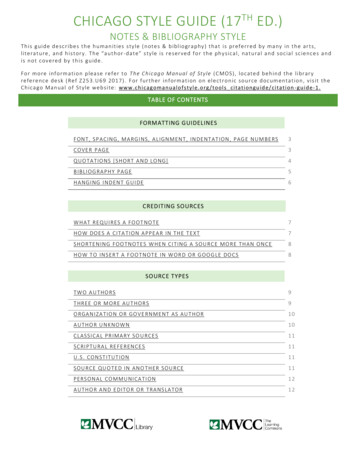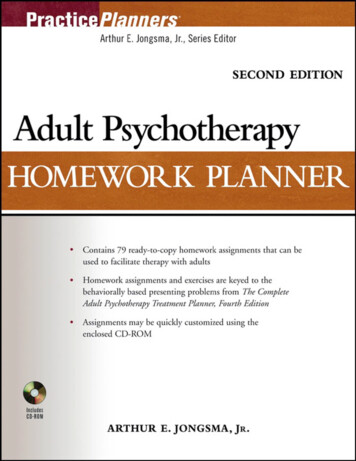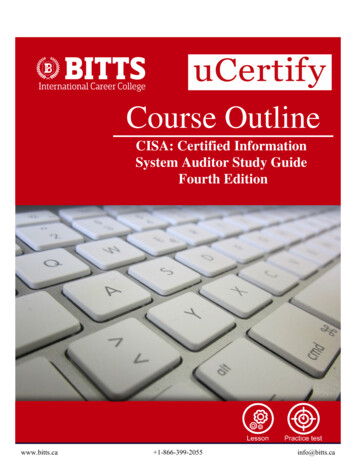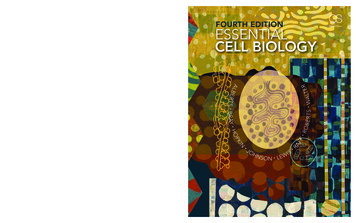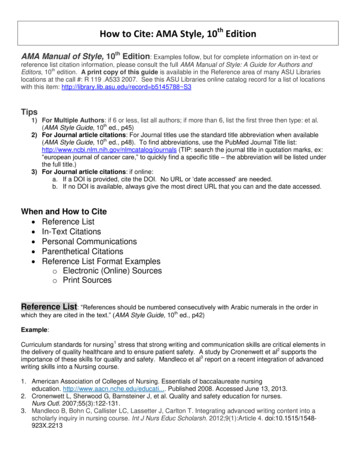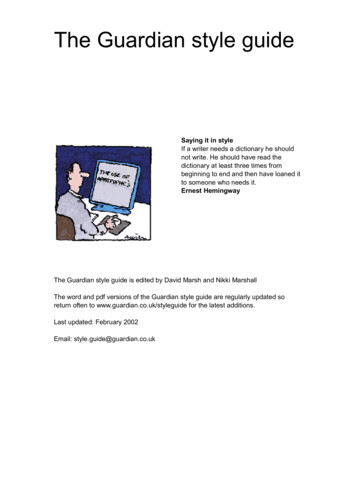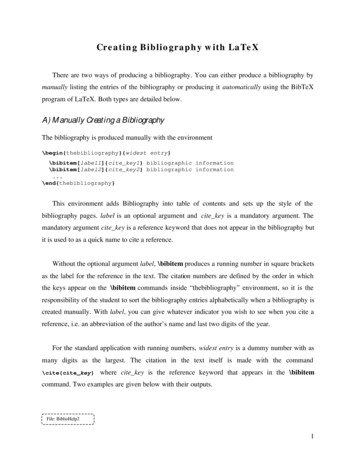
Transcription
California Energy CommissionSTAFF REPORTStyle Manual: Fourth EditionUsed for California Energy Commission Staff,Lead Commissioner, and Commission Reports,Presentations, and PapersGavin Newsom, GovernorMarch 2020 CEC-180-2020-001
California Energy CommissionSusanne Garfield-JonesLana McAllisterCarol E. RobinsonPrimary AuthorsCarol E. RobinsonProject ManagerLindsay BuckleyDirector of Communications andExternal AffairsMEDIA AND PUBLIC COMMUNICATIONS OFFICEDrew BohanExecutive DirectorDISCLAIMERStaff members of the California Energy Commission prepared this report. As such, itdoes not necessarily represent the views of the CEC, its employees, or the State ofCalifornia. The CEC, the State of California, its employees, contractors andsubcontractors make no warrant, express or implied, and assume no legal liability forthe information in this report; nor does any party represent that the uses of thisinformation will not infringe upon privately owned rights. This report has not beenapproved or disapproved by the CEC nor has the Commission passed upon the accuracyor adequacy of the information in this report.
ACKNOWLEDGEMENTSThe California Energy Commission Media and Public Communications Office thanks thefollowing present and former colleagues who laid the groundwork for the 2020 edition:Bob Aldrich, Webmaster emeritusMichael Wilson, graphics director emeritusMargaret (Meg) Larkin, former graphic designerAlbert LundeenAmanda PolettiKevin Kiddi
PREFACEThe fourth edition of the California Energy Commission Style Manual supersedes the 2015version. It is intended to assist California Energy Commission (CEC) staff and others whoprepare CEC reports.“Reports” for this style manual include staff papers, staff reports, Lead Commissioner reports,Commission reports, consultant reports, guidelines, manuals, and project reports for theEnergy Research and Development Division and the Clean Transportation Program of the Fuelsand Transportation Division.This manual is on the CEC website at http://www.energy.ca.gov. The manual and reporttemplates for use with Microsoft Word are on the CEC’s EnergyNet Intranet website athttp://energynet/Exec/doc production/index.html.If you have any questions about the information provided in this manual, please contact theMedia and Public Communications Office (MPCO) at (916) 654-4989.ii
ABSTRACTThe fourth edition of the Commission Style Manual helps staff members, contractors, andproject researchers write clear and concise reports and papers for the California EnergyCommission (CEC). This manual helps ensure that those reports and papers incorporate CECapproved style.This edition includes a new chapter on making documents accessible to readers withdisabilities. As of July 1, 2019, each director or secretary of a state agency must post on theagency website a signed California Department of Technology Website AccessibilityCertification form or the agency’s own form confirming that the website complies with statelaw and the Web Content Accessibility Guidelines 2.0.The word usage chapter in the 2015 editing has been eliminated. Staff members may consultthe EnergyNet intranet “Document Production and Notices” pages for word usage, as well asSection 11 of The Gregg Reference Manual: Tribute (Eleventh) Edition by William A. Sabin.This document, based upon The Gregg Reference Manual and the EIA Writing Style Guide,April 2015, is available online with links from the CEC “EnergyNet” intranet website and at theCalifornia Energy Commission main website, www.energy.ca.gov. Microsoft Word files forthe document templates, covers, and credits pages can be downloaded from those pages aswell.The Media and Public Communications Office may revise this document as necessary. Pleasecheck for the latest version at http://energynet/Exec/doc production/index.html.Keywords: Plain language, acronyms, formatting, usage, accessibilityPlease use the following citation for this report:Garfield-Jones, Susanne, Lana McAllister, and Carol E. Robinson. 2020. Style Manual: FourthEdition. California Energy Commission. Publication Number: CEC-180-2020-XXX.iii
iv
TABLE OF CONTENTSACKNOWLEDGEMENTS.iPREFACE . iiABSTRACT . iiiTABLE OF CONTENTS . vLIST OF FIGURES . viiLIST OF TABLES . viiiEXECUTIVE SUMMARY .1Plain Language .2Preparing Energy Commission Reports .2CHAPTER 1: What This Manual Is About.3Introduction .3Why Should You Use This Style Manual?.3Updates to the Style Manual .4Major Updates Since Last Edition.4CHAPTER 2: Report Contents, Formatting, and Styles .5Report Templates .5Blank Pages .6Figures, Graphs, and Tables.6Report Contents .7Use of Colors in Graphs and Figures, Size of Fonts, and Other Graphic Elements .8Footnotes .8Page Breaks .8Pagination .9Table of Contents, Lists of Figures and Tables .9Report Formatting Styles .9CHAPTER 3: Publication Steps for Papers, Reports, and Presentations . 20Reports and Papers . 20Change in Publication Review . 20Report Sequencing . 22Errata and Additional Revisions to Reports . 23Reproduction . 24CHAPTER 4: Parts, Contents, and General Formatting of Reports . 25Report Sections . 25Cover and Credits Pages for Energy Commission Reports . 26Covers . 26v
Report Credits Page . 26Other Types of Commission Reports . 28Publication Numbers . 29Suffixes at End of Publication Numbers . 29Other Report Sections . 29Acknowledgements Page (Optional). 29Preface Page (Optional) . 30Abstract, Keywords, and Citation Page (Mandatory). 30Table of Contents . 32Executive Summary . 33Chapters and Section Headings . 34References . 35Glossary. 35Bibliography . 35CHAPTER 5: Appendices and Attachments . 36Important Note About Copyrights and Permissions . 36Appendices . 36Formatting and Editing of Appendices . 37Appendices Publication Numbers . 37Page Numbering of Appendices . 37Appendices as Part of the Main Report. 38Appendices as Documents Separate From the Main Report . 39Appearance in Table of Contents . 40Attachments . 40CHAPTER 6: Document Accessibility for Energy Commission Reports . 42What Is Document Accessibility? . 42Seven Principles to Creating an Accessible Word Document . 42Step One: Font Style and Size . 43Step Two: Appropriate Use of Color . 43Step Three: Add Alternative Texts and Captions . 47Step Four: Construct Simple Tables . 49Step Five: Use Meaningful Hyperlink Text . 51Step Six: Use Built-In Formatting Styles . 52Step Seven: Check Accessibility . 52Roles and Responsibilities . 53Document Accessibility Resources . 53CHAPTER 7: Preparing Accurate, Consistent Reports and Report Content Styles . 54Writing Style . 55Acronyms and Abbreviations . 56Bulleted Lists . 59Rules for Bullets . 59Format for Bulleted Lists . 60vi
Capitalization . 60Adjective Phrases and Adverbs. 61Compound Adjectives . 61Internet and Email Addresses . 62Italics . 62Language of Report . 62Legislation (Referencing Legislation in Energy Commission Documents) . 62Numbers. 63Page Breaks . 64Percentages . 64Punctuation . 64Brackets . 64Colon and Semicolon . 65Commas . 65Commas in Dates . 65Hyphen (-), En Dash (–), Em Dash (—). 65Period Spacing . 66Quotation Marks (“”). 66Special Characters and Symbols . 66Underlining . 66CHAPTER 8: Footnotes and References in the Text . 67References Within the Report Body . 67Footnote Citations . 67CHAPTER 9: Submitting Files to the Media and Public Communications Office. 68Word and PDF Files . 68Document Properties . 68Graphics and Figures . 69COMMON EDITOR/PROOFREADING MARKS. 70LIST OF igureFigure1:2:3:4:5:6:7:8:9:Low-Resolution Graphic Downloaded From Internet .6Example of a Graphic Properly Used in a Report .7Example of Abstract/Keyword/Citation Page . 30Example of Table of Contents . 33Example of Appendix as Part of Main Report . 38Example of a "Slip Sheet" for Appendices . 40Colour Contrast Analyzer . 44Incorrect Contrast Pie Chart Example . 46Final Pie Chart . 47vii
Figure 10: Format Picture . 48Figure 11: Describing Graphic Using Alt Text . 49Figure 12: Table Properties. 50LIST OF :6:7:Summary of Formatting Styles for Energy Commission Reports. 10Formatting Style Matrix for Energy Commission Reports . 11Author and Project Manager Review Steps . 20Commissionwide Review Process Steps . 21CEC Publishing Steps . 22Example of Use of Color and Nonredundant Symbols . 46Common and Acceptable Acronyms and Abbreviations . 57viii
EXECUTIVE SUMMARYThe fourth edition of the California Energy Commission’s (CEC) Style Manual assists staffwriters in producing consistent-looking documents in plain language.For this edition, the style manual addresses document compliance with Web ContentAccessibility Guidelines 2.0. These guidelines help make Web content, including reports usingMicrosoft Word and Adobe Acrobat , accessible to a wider range of people with disabilities,including those with blindness and low vision. As of July 1, 2019, all report templates complywith these guidelines, and the CEC mandates that report writers use these templates.Other changes include the following: The new cover has the CEC logo on the top-left corner and the Natural ResourcesAgency logo in the top-right corner. The margins on each side and on the bottom of each report template page have beenreduced to allow more text on the page, thus reducing the amount of paper used. The authors expanded the “Citation Information” subsection to include information onciting articles, reports, journals, books, and Web pages. The list of acronyms in the chapter “Preparing Consistent, Accurate Reports and ReportContent Styles” has expanded. These acronyms can be used on subsequent referencesin the abstract and executive summary of a CEC report In the “Glossary” subsection, the manual writers request that not only an acronym bespelled out, but defined. The chapters “Energy Commission Presentations”; “Required Elements for Fact Sheets,Brochures, Posters, and Other Types of Printed Materials”; “Submitting Files to theMedia and Public Communications Office”; and “Use of the California EnergyCommission Seal” have been deleted. Information from these chapters is available onEnergyNet, the Commission’s intranet site available only to Commission staff. Theinformation can be found by clicking the icon “Document Production and Notices.” The chapter on “Word Use and Misuse” from the previous edition of the style manualhas been eliminated for this version. CEC staff may find these entries under the“Document Production and Notices” icon on EnergyNet. For more information onusage, check The Gregg Reference Manual, Tribute (Eleventh) Edition by William A.Sabin and To the Point: A Dictionary of Concise Writing by Robert Hartwell Fiske. The California Energy Commission encourages the acronym “CEC” in its documents.The bases for this style manual are The Gregg Reference Manual and the EIA Writing StyleGuide. Any issues not covered in this style manual may be found in these references. Otherresources used for this style manual edition include the Merriam-Webster Dictionary; TheChicago Manual of Style, 16th Edition; To the Point; and The Elements of Style by WilliamStrunk Jr. and E. B. White.1
Plain LanguageThe CEC strongly endorses the use of plain language in its documents. Plain language ismandated by the California and U.S. governments. According to the U.S. government atPlainLanguage.gov, plain language can be understood the first time it is read or heard. Plainlanguage uses short sentences, the active voice, everyday words, and logical organization. Ithelps readers find what is needed quickly. Hence, the government’s business is readilyaccessible to the public.Preparing Energy Commission ReportsStaff members preparing a report for the CEC should consult this style manual. The“Document Production and Notices” link on the CEC’s EnergyNet intranet page has resourcesincluding report templates that can help writers prepare documents. Staff members who haveadditional questions may contact CEC Chief Editor Carol Robinson of the Media and PublicCommunications Office at (916) 654-4989.2
CHAPTER 1:What This Manual Is AboutHard writing makes easy reading.— Wallace StegnerIntroductionThe CEC produces hundreds of presentations, reports, brochures, and other printed itemseach year. These publications 1 are used to convey information, printed and sent to libraries,and placed on the CEC website (http://www.energy.ca.gov).CEC management believes that all documents need to have a consistent design; begrammatically consistent, clear, and concise; and have an instant identity with other materialsthe CEC has prepared.As an author, you can demonstrate skill, creativity, and pride in your work as well as anobligation to meet the expectations of your audience and the CEC. Readers should be able torely on consistent, professional quality—regardless of subject matter.CEC Media and Public Communications Office staff understands that you need to know what isexpected to produce a quality publication. This style manual clarifies publication styleconventions, including the approval process and formatting of publications. One chapter isdevoted to writing, including strategies for organizing a document.The CEC does not intend to create a grammar text. Rather, staff wants to address the itemsthat seem most vexing. For a complete and comprehensive source, the CEC recommendsusing The Gregg Reference Manual.Why Should You Use This Style Manual?By using this style manual, you will ensure that CEC documents look consistent andcommunicate well.There are legal grounds for “good writing.” California Government Code Section 6219 states:6219. (a) Each department, commission, office, or other administrative agency of stategovernment shall write each document that it produces in plain, straightforward language,avoiding technical terms as much as possible, and using a coherent and easily readable style.(b) As used in this section, a “state agency document” means any contract, form, license,1 The terms ”publications” and “documents” are used interchangeably throughout this manual to refer to CECreports, papers, brochures, flyers, handouts, presentations, and all other types of printed and delivered materials.3
announcement, regulation, manual, memorandum, or any other written communication that isnecessary to carry out the agency responsibilities under the law.Updates to the Style ManualThe style manual is a working document. Media and Public Communications Office (MPCO)staff will regularly review this manual and incorporate any necessary changes into futureeditions.Major Updates Since Last EditionThere have been changes throughout the style manual correcting errors and mistakes. Thefollowing are the main updates since the previous edition. The new cover has the CEC logo on the top-left corner and the Natural ResourcesAgency logo in the top-right corner. The MPCO Editing Unit prepared this style manualusing one of several report templates that ensure the content is accessible to readerswith disabilities. The margins on the sides and the bottom of each report template page have beenreduced to allow more text on the page, thus reducing the amount of paper used. The list of acronyms in the chapter “Preparing Consistent, Accurate Reports and ReportContent Styles” has expanded. These acronyms can be used on subsequent referencesin the abstract and executive summary of a CEC report In the “Glossary” subsection, MPCO requests that an acronym be not only spelled out,but defined. The chapters “Word Use and Misuse”; “Energy Commission Presentations”; “RequiredElements for Fact Sheets, Brochures, Posters, and Other Types of Printed Materials”;“Submitting Files to the Media and Public Communications Office”; and “Use of theCalifornia Energy Commission Seal” have been deleted. Information from thesechapters is available on EnergyNet, the CEC’s intranet site available only to CEC staff.The information can be found by clicking the icon “Document Production and Notices.” This style manual includes a chapter on document accessibility for impaired readers.The chapter outlines instructions on checking a report for accessibility compliance withthe Americans with Disabilities Act. The abstract should be on an odd-numbered, right-hand-facing page.4
CHAPTER 2:Report Contents, Formatting, and StylesAll California Energy Commission (CEC) reports contain the following sections, in the followingorder: Cover page (required) Credits page on the reverse side of cover (required) with legal disclaimer (mandatoryon committee, staff, consultant, and research and development and CleanTransportation Program project reports) Acknowledgements page (optional) Preface (optional) Abstract, keywords, and citation page (required) Table of Contents (required, followed by List of Figures and List of Tables, if needed) Executive Summary (optional but required on policy and project documents) Body of the report References (if applicable) Glossary/Acronyms (If more than 10 acronyms or abbreviations are used, it isrequired. Definitions are also required.) Bibliography (if applicable) Appendices (if applicable) (Create a separate volume if very large.) Attachments (if applicable)Later chapters discuss report contents and parts.Report TemplatesPrepare the report using one of the CEC-approved templates. The templates are Americanswith Disabilities Act (ADA) accessible. Use the report typographic styles described in thismanual. They are summarized in Table 1: Formatting Style Matrix for Reports. The styletemplate—and boilerplate cover and credits page templates—are on the CEC EnergyNetintranet website under the icon “Document Production and Notices.” Do not deviate fromthe report template.All CEC computers should be set up to have the Commission style formats as the default inMicrosoft Word. All other styles can be stripped from Word formatting palette. If a report hasbeen written elsewhere, it may need to be reformatted using the CEC style.For formatting help, please see the step-by-step instructions on EnergyNet athttp://energynet/Exec/doc production/formatting/index.html.5
Blank PagesInsert blank pages after the following pages so that the next section begins on the right-handside. Following single-page acknowledgement page if there is no preface Following table of contents, list of figures, and list of tables Following executive summary (if used)Place the disclaimer page for a staff paper behind the cover. The credits page for other reportsis on the backside of the cover. Please make sure the abstract is on an odd-numbered, righthand-facing page. Do not put blank pages at the end of chapters so that next chapter beginson the right side. Only Chapter 1 needs to be on an odd-numbered, right-hand-facing page.Figures, Graphs, and TablesFigures, graphs, and tables (graphics) should be clear and readable. Source lines arerequired on all figures and graphs.The graphic should be introduced in the paragraph before and explained fully. The explanationof the graphic may be used as alternative (alt) text for document accessibility. Do notdownload and use low-resolution graphics from the Internet, such as in Figure 1. While thesemay appear fine on your computer monitor, when printed, the picture may look blurry.Figure 1: Low-Resolution Graphic Downloaded From InternetExample of logo downloaded from the CEC website and enlarged for effect.Graphics or photos used on the internet are typically done as 72 or 96 dots per inch(dpi) graphics files. Most reports are printed at 300 dpi. Therefore, the graphic willappear very blurry when printed.Source: California Energy Commission, Media and Public Communications OfficeWriters should provide alternative text for the graphic. In the document, go to the “File” tab.Under “Info,” select “Check for Issues,” then select “Check Accessibility.”The title or label of graphic should be typed in as part of the report and not part of thegraphic. The reason is that the graphic may have to be resized to fit the page. If the label ispart of the graphic, the size of the label will change depending on the resizing of the graphic.The figure title should use the “Figure Titles” style in Tahoma, 12 pt., bold, centered similar tothe example in Figure 1. The figure title should be in title case, be centered, and ha
The fourth edition of the California Energy Commission’s (CEC) Style Manual assists staff writers in producing consistent-looking documents in plain language. For this edition, the style manual addresses document compliance with . Web Content Accessibility Guidelines 2.0. These
